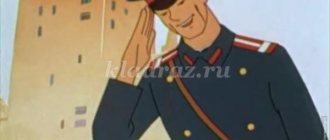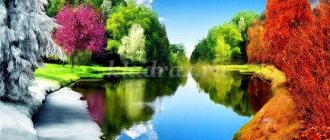On the topic: methodological developments, presentations and notes
Plan of drawing notes (preparatory group) on the topic: “Winter Landscape” using the non-traditional “Imprint” technique (drawing with vegetables).
Topic: “The Adventures of the Hedgehog” (dry brush, combing paint) Visual tasks: - continue to learn how to use a combination of colors to create an image of autumn - continue to learn by mixing.
Program content: Learn to draw rowan, highlighting the characteristic features of the bunch. Reinforce the idea of the color red; cultivate interest in collective creativity. Continue learning doat.
MBDOU "CRR - kindergarten "Bell" Summary of direct educational activities in drawing in the 1st junior group "Winnie the Pooh" Topic: "Wheels for the train" (non-trad.
summary of a drawing lesson in the junior group “Beasts in the Forest.”
Drawing outline for Cosmonaut Day using non-traditional drawing techniques.
Source
Preview:
Summary of a drawing lesson in the senior group
“Decorate your boot with a Bashkir pattern”
- To develop in children the ability, using familiar and new elements of the Bashkir ornament, to decorate the Bashkir boot - itek; consolidate knowledge of the compositional construction of a pattern, apply the coloring characteristic of this product.
- improve children’s ability to saturate the brush well with paint, hold it obliquely when drawing wide lines and vertically when drawing narrow lines; develop artistic taste.
- cultivate love for the native land and accuracy in work.
Activation of the dictionary: itek, bird's head.
Devices and materials:
Silhouettes of Bashkir boots for each child; gouache paints; brushes for decorative painting; plastic jars with water; cups for brushes; napkins; linings; magnetic easel; algorithms for drawing a new element “bird head”; picture with different shoes; Dunno doll; tape recorder with a recording of a Bashkir melody.
- viewing illustrations depicting people in Bashkir national costumes; acquaintance with dolls in Bashkir costumes.
- conversations about the Bashkir ornament: its construction, elements, color.
- d/games: “Decorate the boot” (ready-made elements of the Bashkir ornament), “Weave a carpet” (drawing a Bashkir pattern from geometric shapes), “Trace and color” (templates of elements of the Bashkir ornament), “Dress Aigul and Salavat.”
- decorative drawing in previous lessons: “Decorate the tablecloth”, “Beautiful towel”.
- modeling “Bowl for Aigul”,
- visit to the Center of National Cultures.
Educator: Good afternoon, October people. Why did I call you that?
Children: we live in the city of Oktyabrsky.
Educator: What republic do we live in?
Children: we live in Bashkortostan.
Educator: Our republic is peaceful and hospitable. People of different nationalities live in it in friendship and harmony.
The group includes Fairuza Frvazovna (in Bashkir national costume)
Fairuza Frvazovna: Hello, guys (says hello in Bashkir). I came to you for help. Please help me decorate Bashkir boots for kids to play with.
He takes out the silhouettes of a Bashkir boot from a large envelope.
Fairuzu F.: Look what I brought you. This boot is called - itek - Repeat, guys, what it’s called.
Fairuzu F.: Pay attention to the appearance of the boot. It is straight, without a heel, on the top there is a black stripe that needs to be decorated with a Bashkir pattern.
Educator: Don’t worry, Fairuza Farvazovna, our guys will definitely help you and decorate your boot with a Bashkir pattern.
Fairuza F.: Thanks guys, I'll come see you later.
Dunno: I also have Bashkir boots, look how many there are.
Shows a picture with different shoes.
Children: No, Dunno, there are no Bashkir boots here, there are different shoes here.
Educator: How did you find out?
Children: The Bashkir boot is straight, without a heel, and has a black stripe on the top.
Educator: Correct. I propose to decorate a Bashkir boot with this pattern (showing a sample). Look at the pattern, what elements does it consist of?
Children: From circles and diamonds.
Educator: Please note that the diamonds are not simple, they have branches. This element is called a “bird’s head”.
Go find yourself a place to paint.
Children set up tables and take their places.
Educator: So what are we planning to do with you?
Children: Decorate the boot with a Bashkir pattern.
Educator: What do we need for work?
Children: Paints, brushes, water, pads, napkins. We will do everything in order, and we will get a beautiful Bashkir boot.
Educator: Go, prepare everything you need for work.
Children are preparing jobs.
Educator: Now come to me, I will teach you how to draw this Bashkir pattern. First, I will visually divide the black stripe into two parts with a horizontal line (I show with my hand). I will draw circles at the top and a diamond at the bottom. I’ll draw a cross at the bottom of the black stripe: I’ll draw a long stripe from top to bottom, and a short stripe in the middle. I connect the ends of the cross to form a rhombus, paint over it and draw the branches - the stick up and a little down.
Educator: Kamila, how do I paint, with the whole brush or the tip?
Camila: With the tip of a brush
Educator: Vasya, tell me, what colors can you use to paint the Bashkir pattern?
Vasya: Red, orange, yellow, burgundy, green.
Educator: Tell me, Vika, where will you start drawing this element of the pattern?
Vika: I’ll draw a cross, then connect the ends and make a diamond.
I will paint over the diamond and draw the branches.
Educator: Go and draw.
The teacher puts on the board algorithms for drawing a complex element and an example of a Bashkir pattern.
Independent activity of children (to a Bashkir melody)
While the children are working, the teacher pays attention to the children’s posture and reminds them of the drawing technique: paint with the tip of a brush, rinse the brush well, then add new paint, etc.
Educator: What pattern did you decorate the itek with?
How can you find out that this is a Bashkir ornament (list the elements of the Bashkir ornament, color).
Well done guys, what beautiful Bashkir boots you drew for kids.
Source



